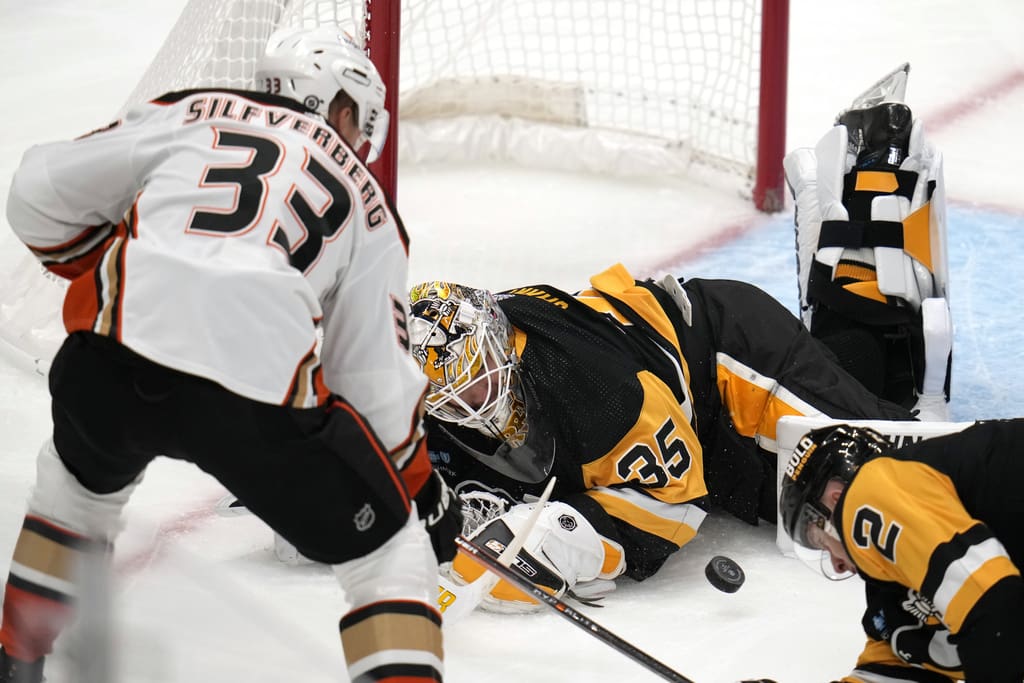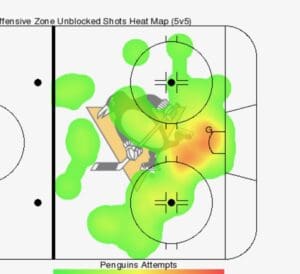Penguins
Penguins Breakdown: It Keeps Going Wrong, Takeaways & Player Grades

The Pittsburgh Penguins had a moment on Monday, the self-perception rattling sting of which may linger. There are moments within a season that shine brighter, wins that change the direction of a team, but also losses that humble even the most ambitious. Those moments only reveal themselves afterward, and the effects are often left to the impact felt by the recipient.
And if the Penguins locker room Mondy night is any indication, the 4-3 last-second loss to the Anaheim Ducks was a flurry of body blows that made a dent in the team psyche.
The team is asking itself why but is finding no consolation, only a soul-crushing lack of answers. The Penguins game featured opportunities but self-inflicted disappointment.
Again.
In a microcosm of the Penguins season, Sidney Crosby had a wide-open net in the final seconds of the first period. His shot was headed into the yawning cage, but goalie John Gibson twisted awkwardly, extending his stick to deny a sure goal. Crosby looked to the ceiling. Gibson was injured on the miraculous save. And the Penguins were denied an important goal.
Penguins’ Game Analysis
The Penguins flirted with their defensive posture in the first period, reaching for the 1-2-2 counter on a couple of occasions. Still, they simultaneously held onto pucks in the offensive zone while also settling for a low-event period.
The number of things the Penguins did right was balanced not by mistakes but by questions of whether they did enough or pushed hard enough in the first 40 minutes. The Ducks are not generally a hard team to play against, and while the Penguins took every inch of ice that the Ducks gave, they needed to take more.
“I think when you look at the way the games are being played here, the last handful of games, there’s been significant amounts of time that we’ve been the better team,” said Sullivan. “Right now, we’re finding ways to lose.”
I’ll disagree with Sullivan to some extent; the Penguins accepted the perimeter but didn’t do enough throughout their lineup to pressure the interior of the ice in the first two periods.
They dominated the third period but again victimized themselves with costly mistakes. Fumbling the puck at the blue line with a 5v3, allowing a breakaway goal as McTavish came out of the box to win it with 13 seconds is about as hard luck and yet careless as it gets.
It’s no wonder that according to NaturalStatTrick.com, the Penguins had a 57-43% Corsi advantage, but the scoring chances and high-danger chances were about even after two periods.
Against the Ducks?
Credit to Anaheim for progressing in their rebuild. They are filling the net and winning some games, but that’s not exactly the 2006 Ducks with Chris Pronger and Scott Neidermeyer on the blue line. If I rattled off all six defensemen, you’d recognize two, maybe three. It’s not fearsome, but the Penguins treated it as such.
Sullivan said the Penguins carried the play, and while that may be true, look at the lack of heat around the net. The Penguins had 42 shots but barely an afternoon rain shower near the net. This is the problem that they seem to be dancing around.

As well as Bryan Rust is playing–and he’s at peak form–the Penguins top six is missing someone to move a defenseman, block the goalie’s sightline, or generally make it more difficult for the opponent to defend their net and easier for the Penguins to shoot at it.
In that regard, the Penguins are playing too pretty. Rickard Rakell remains a talented Dr. Jack Griffin (the Invisible Man).
However–the Penguins did MUCH better in the third period. Led by the third line and Radim Zohorna, who bullied his way to the net and had one of the best periods of his NHL career, the Penguins reversed course.
Zohorna scored the tying goal after a backcheck steal when he buried O’Connor’s rebound at the net.
More of that.
Side note: Don’t be surprised if you see Zohorna in the top six soon. The big man is earning it, and the best argument against it would be an unwillingness to break up what is becoming a pretty good third line.
Pittsburgh Penguins Report Card
Team: C
Maybe this is who they are? If this is who they are, perhaps they’ll need to counterattack more or unleash their two All-Star defensemen. On the Penguins first 17 shots, their average distance was 31 feet.
For the “Fire Canada” crowd, that’s 10 feet farther than most Steelers passes.
The Penguins aren’t consistently making themselves dangerous even when they dominate the puck. The third period contained much of who they needed to be, but two mistakes at crucial moments were in their net.
Guentzel-Crosby-Rust: A
Crosby’s line has been the exception to the rule in the last couple of games. After two periods, Crosby’s line had more shot attempts (13) than the other three lines combined (11), more scoring chances (6) than the other three lines combined (2), and had the only high-danger chance for either team.
(The high-danger chance is a bit misleading. It’s surely high danger when a two-on-one becomes chaos and a bouncing puck in the crease. Anaheim had one of those sequences. Crosby’s line had a couple of scrums near the net, too).
Malkn’s line, as well as the third line, had hard-charging third periods to close the statistical gaps, but Crosby’s line was the best for either team.
Nieto-Acciari-Carter: D
The best you can say is they weren’t scored upon. Zero shots compared to four against. They weren’t asked to start an overwhelming number of shifts in the defensive zone, as two of their four faceoffs were in the neutral zone.
One particular sequence in the first period was particularly aching. Jeff Carter carried the puck through center ice into the offensive zone. Sensing a chance, he hit top speed and got an angle on the defenseman. However, his shot missed the net badly and sprung Anaheim on an odd-man break.
Energy, momentum, spark? The Penguins’ fourth line does not give these things.
Radim Zohorna: A+
The big man decided he was going to the net, and Anaheim had no say in the matter. Zohorna pushed hard for a win, taking the puck to the net and around the net several times in the third period. Those sequences build on good puck possession and chances in the second period.
Zohorna scored the go-ahead goal less than 90 seconds into the third period. (The Penguins gave up the tying goal 96 seconds later on a busted breakout that became the first Mason McTavish breakaway goal.
Power Play: B
They scored two power play goals, though one was a 5v3 late in the second period, and the two-man advantage was perhaps a bit of a gift from the refs. The Penguins seemed to be squandering their full two-minute two-man advantage until Evgeni Malkin blasted one past Lukas Dostal.
The Penguins first power play was a thing of beauty. It was simple. Jake Guentzel and Reilly Smith (newly included on the top unit) went to the net, and Erik Karlsson blistered a shot through traffic. That’s how it’s supposed to work.
Other attempts were pass-a-thons that had possession but little pressure.
Tristan Jarry: C
There’s a lot of heat on Jarry, and it’s probably deserved. Jarry is making the easy saves, but he’s allowing a lot of goals that could be stopped. I don’t think anyone is particularly happy with Jarry’s play, including the goalie himself.











